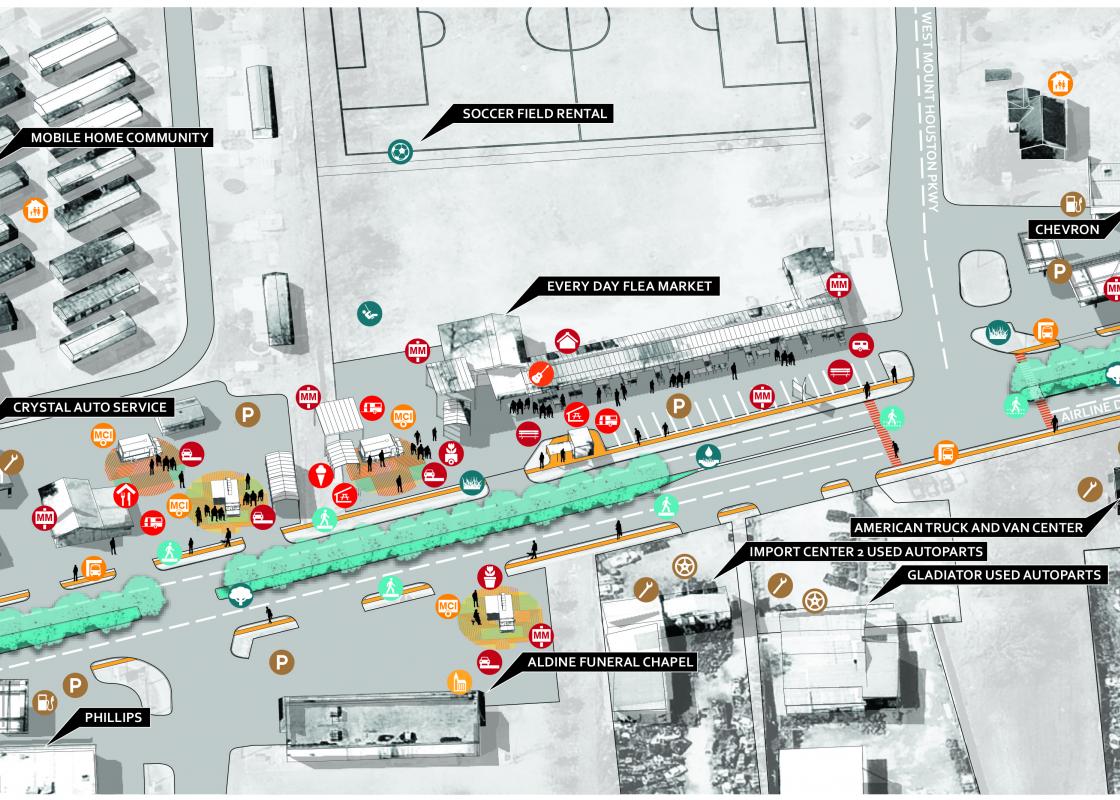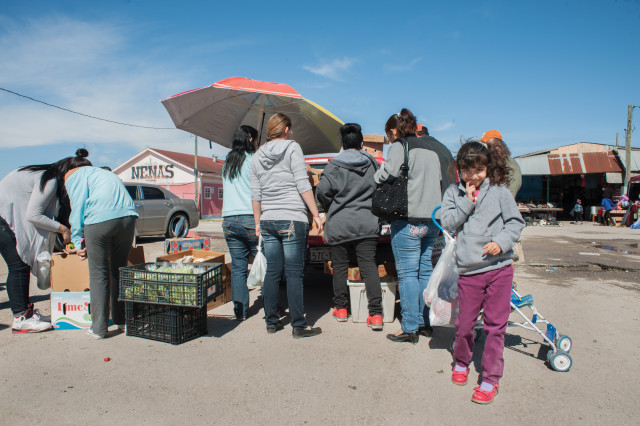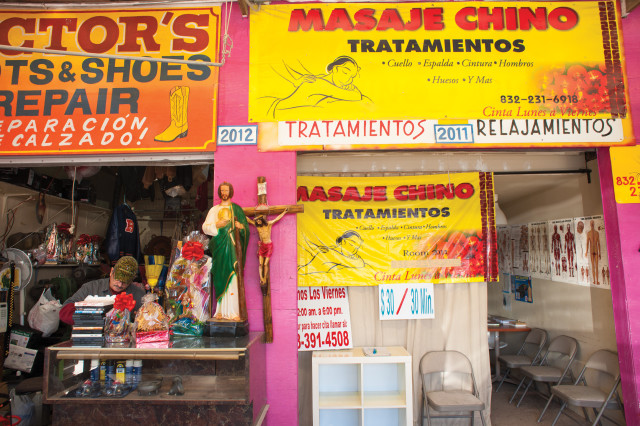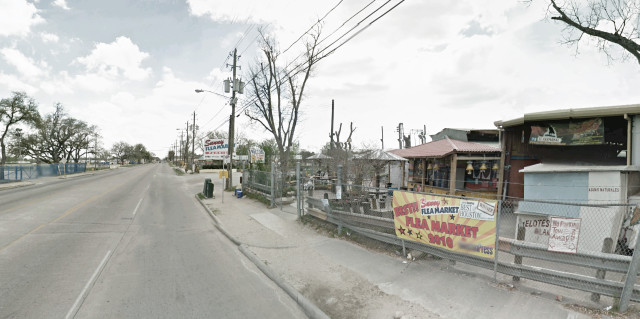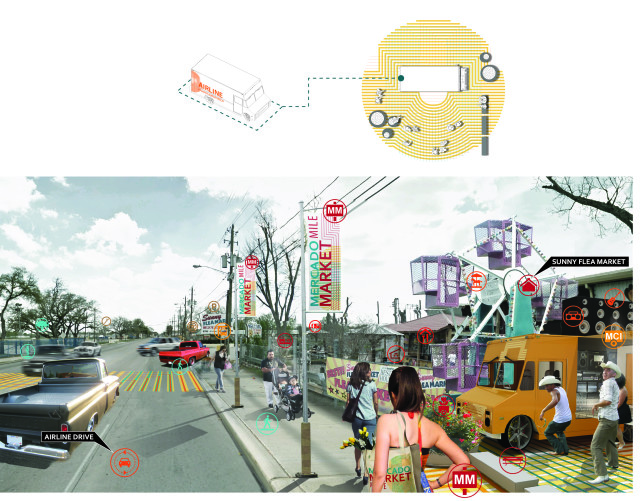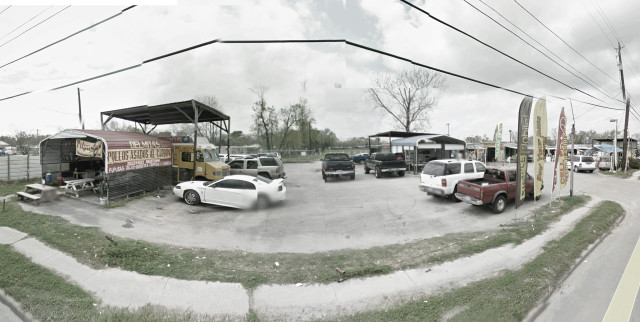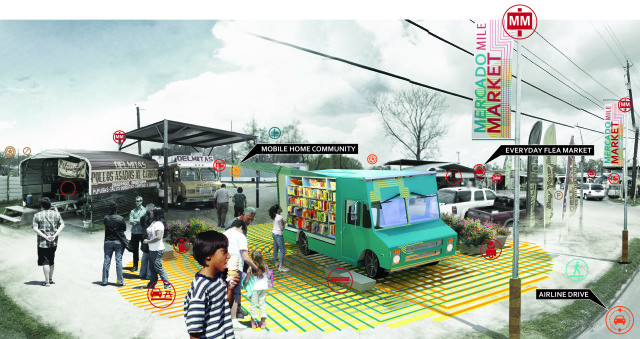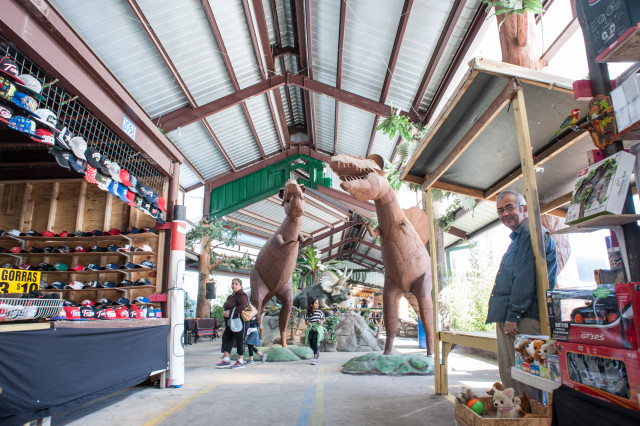This article proposes a mobile fleet of community-service-oriented trucks and a marketing campaign to strengthen one of Houston's most vibrant neighborhoods. The full text appears in the new issue of Cite, "The Beautiful Periphery." The issue is available for purchase at Brazos Bookstore and River Oaks Bookstore, as well as the bookstores at the Menil Collection; The Museum of Fine Arts, Houston; the Contemporary Arts Museum; and the Blaffer Art Museum. Read more from Cite 94.
Every weekend, tens of thousands of people converge on Airline Drive’s flea markets to shop and enjoy live entertainment. It’s rare to see pedestrians in droves in other Houston suburbs, but here families and teenage couples, dressed in their best, flock to simple outdoor eateries as they make their way through the pulgas. The selection of merchandise ranges from cowboy boots and household appliances to religious paraphernalia, records, dresses for quinceañeras, oversized colorful piñatas, puppies, and live birds. But shopping is only part of the carnival atmosphere of carousel rides, live music, and soccer matches replayed on television. Food counters overflow with roasted corn, tacos de trompo (typically pork marinated in pineapple juice that’s hard to come by elsewhere in Houston), and freshly prepared churros. Unlimited combinations of fruit dressed with chile powder, lime, salt, cream, and soda make for refreshing snacks on hot summer days. There are sculptures of elephants and giant ducks; especially popular with children are the life-sized fiberglass dinos in the “Dinosaur World” exhibition that was carefully rebuilt after it burned down a few years back.
Outside the markets, hand-drawn signs mark endless stretches of auto salvage yards, pawn shops, tire dealers, secondhand furniture stores, and laundromats. Mobile vendors seem to make use of every leftover space, whether in driveways and strip-mall parking lots or next to gas stations and warehouses. Fences of every color and configuration line the car lots and freestanding retail enterprises, speaking to the security-conscious sensibilities of property owners in the neighborhood. Nothing here looks tidy or planned, but everything in the neighborhood is purposefully designed in a kind of “Folk Urbanism” style to achieve a livable, self-organized matrix. Ordinary commercial activities have shaped this part of our city in a remarkable way.
The Airline Improvement District (AID) is not even in Houston: it is an island within Harris County, surrounded by the City of Houston but not within its corporate limits. Located on Airline Drive one and a half miles north of Loop 610 and minutes south of the George Bush Intercontinental Airport, it is roughly twice the size of Houston’s Downtown. The majority of the local population is young and Hispanic. The area suffers from a number of serious infrastructure problems: it lacks a centralized water service, experiences repeated bayou flooding, affords only limited police patrol, endures soil and water pollution, and is poorly connected by roads initially conceived for rural traffic only. The flooding is so severe that 50 percent of the district’s land area is within the floodplain, which impacts investment in new housing and water/ sewer services. Fifty-six percent of AID homes were built prior to 1970. Residents modify aging structures to accommodate growing families.
Though flea market activity is the district’s strongest socioeconomic asset, the AID management is more heavily focuses on local infrastructure as an economic and investment driver than on direct business development. Taking this cue to provide complimentary outcomes, SWA Group proposed a unique branding and networking strategy that brings together local business and district representatives. Because of the need for basic community services and economic growth, as well as AID management’s desire to connect their work to the community, a programmatic structure was designed to bring new services to the area. This structure, called the Market Mile (MM) and Mobile Community Infrastructure (MCI), leverages the concentrated entrepreneurial and social activity surrounding the flea markets to create a dynamic partnership between business and home owners, and AID management.
Market Mile
The first step, which is to rebrand the stretch of Airline Drive between West and Canino Roads as the “Market Mile,” would turn this local phenomenon into a well-known and popular Houston destination. In addition to that, partnerships between AID management and flea market vendors would lay the foundation for a new kind of dialogue between business and home owners and planning agencies. This dialogue would give managing government entities an entrepreneurial role in improving the district, provide business owners with a forum and a resource network, and actively market the area’s goods to the greater Houston region. The incentive for business owners to join the network would be its ability to advertise, include them as a local resource, and aid in the process of their entrepreneurial growth. To grow support for the Market Mile at a local level, the district would organize family-oriented events and activities and provide free advertising to participating establishments. Eventually, streetscape modifications and signage along Airline Drive would solidify the campaign’s branding component.
As a district initiative, the Market Mile would seek to stabilize local businesses and initiate tax-base expansion. New tax revenue could then be spent on building water, sewer, street, and flood mitigation infrastructure. In addition, the resulting network of Market Mile business owners could lobby for important measures like flood mitigation from the Harris County Flood Control District.
Mobile Community Infrastructure
Where the Market Mile would begin the dialogue between business and home owners and AID management, the MCI program would extend that conversation to locations not always associated with the commercial spine of Airline Drive. Learning from how people in the district currently use their space, MCI would take shape in the form of a mobile fleet of trucks. Mobile food and retail currently operate very successfully within the existing vacuum of public services and regulation. At a fundamental level, expanding this network would provide people with basic things that could improve, even transform, their lives: help in borrowing a book or renting a computer, language lessons, or assistance with paying tickets and applying for permits and loans. Part of the fleet could be set up to provide additional commercial services, like bicycle repair or programs that involve kids in music, art, and design. Many of these amenities are not available now and are not likely to become part of the district’s hard infrastructure in the near future. The mobile fleet would leap over this deficiency and formalize the burgeoning community network by seeding it with the basics, cultivating culture, and offering easily accessible educational opportunities to residents of all ages. The vision is flexible and scalable to what is needed most. With a minimum design intervention (paint on pavement and some movable planters), parking plazas could be strategically set up throughout the district to host the fleet on a rotating schedule.
The proposed coupling of physical and social infrastructure allows for the construction of an organized foundation to leverage existing district activities as well as provide services that enhance and redefine the district. As the physical infrastructure is developed and the area undergoes change that is both desired and inevitable, the community will be able to take ownership of the area and become an integral part of the planning conversation.
The core team at SWA Group that created this proposal includes James Vick, Kinder Baumgardner, Jenny Janis, Jason Pierce, and Natalia Beard.
More >>>
Read all content from Cite 94.


